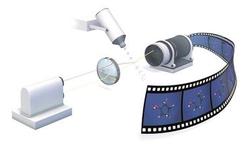FEL Science
Free electron lasers are unique light sources to probe any kind of matter at atomic length and time scales. They cover a huge spectral range from THz to hard X-rays and provide intense, coherent and ultra short pulses to address fundamental research questions across the disciplines of physics, chemistry, materials and life sciences. FELs are needed to improve our understanding of processes at the atomic and molecular level, in order to be able to develop new materials and methods for tomorrow’s technological advancement, a clean environment, sustainable energy and health care. Below are some science applications of FELs and their potential benefits.
Serial Femtosecond Crystallography
SFX is a method whereby molecular structures can be determined by collecting a large number of single shot diffraction patterns from a stream of nanocrystals. The highly intense FEL pulses enable nanometer sized crystals to be examined, thus allowing determining the structure of many important bio-molecules which do not form large enough crystals for standard structure determination using synchrotron radiation. Ultrafast snapshots permit the diffraction data to be recorded before the specimen can be affected by radiation damage.
Societal benefits of SFX
SFX will enhance the understanding of the structure of biomolecules which may lead to the discovery of new drugs for some of today‘s challenging diseases. More information
Quantum Materials
Quantum materials are new, promising materials such as high-temperature superconductors, topological insulators and multiferroics, which have novel and unusual electronic properties and can revolutionize technology. X-ray FELs permit the observation of ultrafast, photo-induced transitions of the atomic, charge, spin and orbital order of quantum materials. Infrared FELs permit non-linear excitations of these transitions with high spectral resolution.
Societal benefits of Quantum Materials
This research enables the development of materials with new functionalities being controlled with light and of new strategies for high speed device applications. The rich, short-range texture of the electronic phases of quantum materials may one day be used to encode information at unprecedented densities.
Femtochemistry
Femtochemistry is concerned with the study of chemical reactions at their natural atomic, femtosecond time scale in order to understand - and possibly control - the atomic motions as reactions unfold and pass through their transition states. Intense, femtosecond X-ray FEL pulses are essential to resolve the motion of individual atoms during a chemical reaction. In combination with synchronised ultrafast optical lasers, it is possible to take images during the reaction and to construct a molecular movie
Societal benefits of Femtochemistry
The detailed understanding of ultra-fast molecular dynamics may allow controlling chemical reactions and thus enhance e.g. catalytic processes in chemical industry. Femtochemistry also will help to develop new and more efficient processes.



